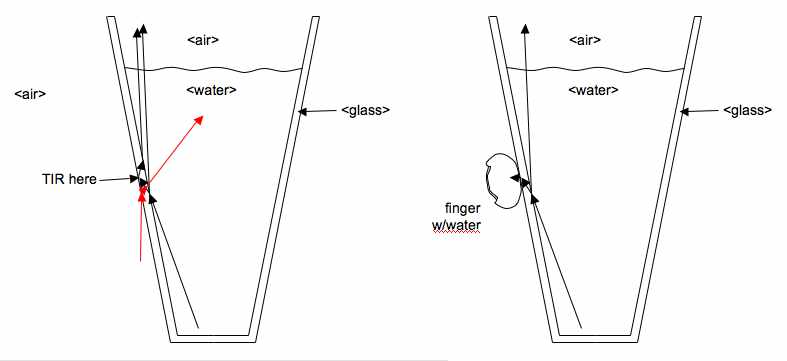Date: Mon Mar 17 19:06:45 2008
Posted By: John Link, Senior Staff Physicist
Area of science: Physics
ID: 1205729846.Ph
Message:
The question: "Why can you see your fingerprints on the side of a
glass?
If a glass of water is peered into from above all that can be seen is the
inside of the glass. The sides of the glass reflect what's inside. If you touch
the outside of the glass, suddenly you can see through, except in the valleys
of the finger prints which still display a reflection. This only works if the
outside of the glass is wet. What physics are involved? Why doesn't the side
of the glass just continue to reflect the inside of the glass?"
The phenomenon you are experiencing is total internal reflection (TIR)
without the finger on the outside, or the lack of TIR when the wet finger is
present on the outside. You can find out details of TIR in many places,
one of them being
here
at hyperphysics.
Look at this sketch:

From the hyperphysics site you know that it is possible to calculate
the minimum angle of incidence that will be totally internally reflected
(the critical angle), if you know the two substances. And we do know. For
light that enters the side of the glass from the water and then encounters
the glass-air interface at the outside surface of the glass, assuming that
the refractive index of the glass is 1.50 and that of air is 1.00, the
minimum angle of incidence for TIR (the critical angle) is about 41.8
degrees. It is very easy to exceed that angle: For light that enters the
glass material at an angle of incidence of, say, 80 degrees at the inside
water-glass interface, the incident angle of the ray at the glass-air
interface is about 60.8 degrees and so is totally reflected.
So why does the surface of the glass appear mirror like? Because no
light can enter your eye from the outside of the glass, so any light that
does get to your eye is mostly reflecting by TIR at the glass-air interface
and originates from the bottom of the glass. These rays are represented in
black in the lefthand glass. But now look at the red rays. Any ray
entering the glass from the outside can have at most an angle of
refraction, inside the glass material, of 41.8 degrees (which is the
critical angle of a glass-air interface with glass of refractive index
1.50), and such a ray will have an angle of refraction at the inside
glass-water interface of at most 48.8 degrees, and will go through the
water at an angle similar to the inside red ray shown. If your eye is
intercepting the black rays, it will not see the red rays!
But when one applies a wet finger (or any other object that can trap
water so that it is in good contact with the outside surface of the glass)
as shown in the righthand glass, the incident angle of 60.8 degrees no
longer exceeds the critical angle! The critical angle at a glass-water
interface (the refractive index of water is about 1.33) is about 62.5
degrees for our glass material, which you can verify by calculating. So,
much of the light that previously reflected totally at the glass-air
interface and reached you eye is now entering the finger (or other object)
and being absorbed or scattered so that it no longer makes it to your eye,
and you see it as a dark area.
You can see ridges of your fingerprint because there are valleys in your
fingerprint which may not have water trapped in them. Indeed, if your
finger is too wet you will see a uniformly dark area rather than
fingerprint ridges. (A secondary effect that allows you to see fingerprint
ridges is the different amounts of absorption or scattering by the
different thicknesses of the skin represented by the fingerprint.)
John Link, MadSci Physicist
Current Queue |
Current Queue for Physics |
Physics archives
Try the links in the MadSci Library for more information on Physics.
MadSci Home | Information |
Search |
Random Knowledge Generator |
MadSci Archives |
Mad Library | MAD Labs |
MAD FAQs |
Ask a ? |
Join Us! |
Help Support MadSci
MadSci Network,
webadmin@madsci.org
© 1995-2006. All rights reserved.
